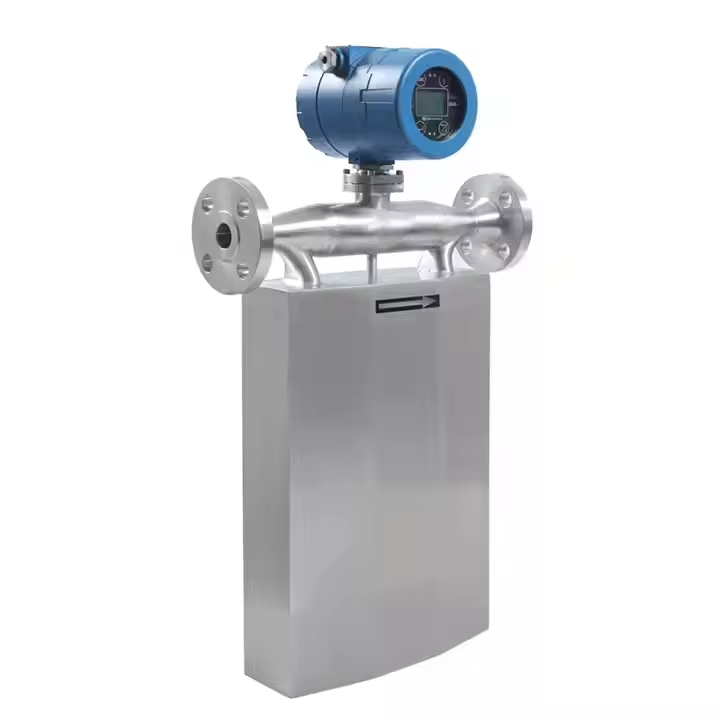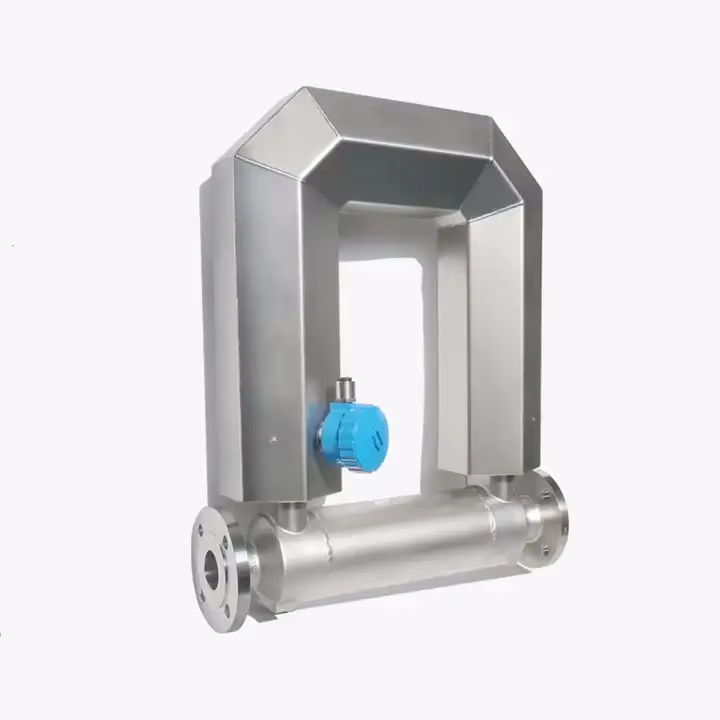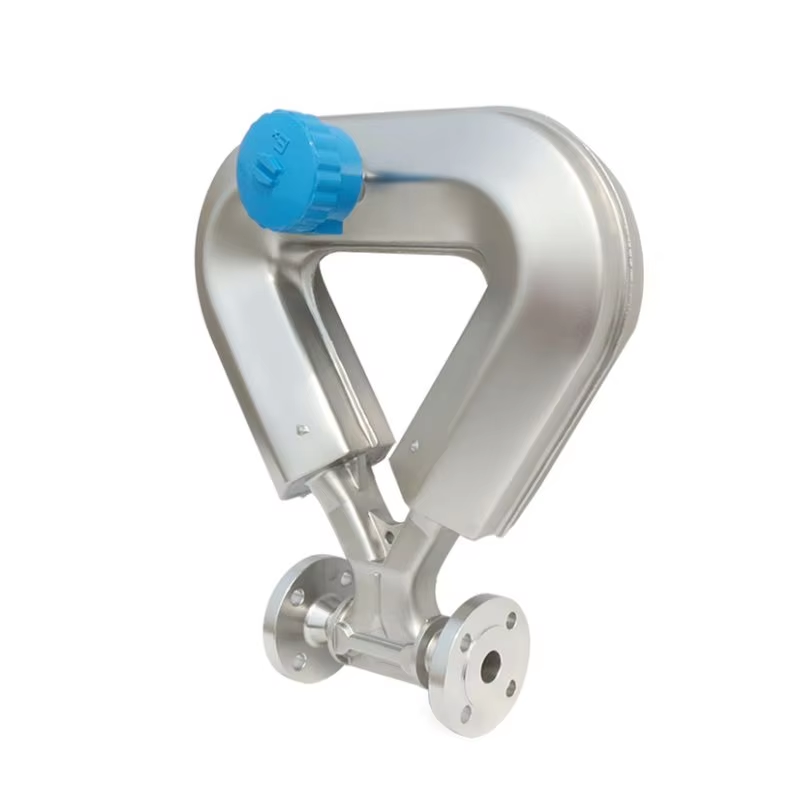The volume of a fluid is a function of the temperature and pressure of the fluid and is a dependent variable, while the mass of the fluid is a quantity that does not change with changes in time, space temperature, or pressure.As mentioned earlier, the commonly used flowmeters, such as orifice plate flowmeter, laminar mass flowmeter, turbine flowmeter, vortex flowmeter, electromagnetic flowmeter, rotor flowmeter, ultrasonic flowmeter and elliptical gear flowmeter flow measurement value is the volume of fluid flow.In scientific research, production process control, quality management, economic accounting and trade and other activities involving the amount of fluid is generally more for the quality.The use of the above flowmeter only to measure the volume of fluid flow often can not meet the requirements of people, usually also need to try to get the mass flow of the fluid.Previously, only in the measurement of fluid temperature, pressure, density and volume and other parameters, through the correction, conversion and compensation methods to indirectly get the quality of the fluid.This measurement method, more intermediate links, the accuracy of mass flow measurement is difficult to ensure and improve.With the development of modern science and technology, there have been a number of direct measurement of mass flow measurement methods and devices, thus promoting the progress of flow measurement technology.

Brief introduction
Fluid flowing inside a rotating tube exerts a force on the tube wall, which was discovered by Coriolis in 1832 during his study of the turbine, referred to as the Coriolis force.In 1977 the founder of the American company Micro Motion developed the world's first practical mass flow meter based on this principle.Mass flowmeter based on Cohen's force, there are two parallel flow tubes inside the sensor, the central part is equipped with a driving coil, the two ends are equipped with detection coils, the transmitter to provide the excitation voltage added to the driving coil, the vibration tube for the reciprocating cycle of vibration, the industrial process of the fluid medium flowing through the sensor vibration tube, will produce Cohen's force effect in the vibration tube, so that the two vibration tube torsion and vibration, the detection coil installed in the vibration tube at both ends will produce two sets of signals with different phases, the detection coil will produce two sets of signals with different phases.The detection coil installed at both ends of the vibration tube will produce two sets of signals with different phases, the phase difference between the two signals is proportional to the mass flow of the fluid flowing through the sensor.The computer solves the mass flow rate through the vibrating tube.Different media flow through the sensor, the main vibration frequency of the vibration tube is different, according to the solution of the medium density.Installed in the sensor vibration tube on the platinum resistance can indirectly measure the temperature of the medium.
Mass flow meter directly measures the mass flow of the medium through the flow meter, but also can measure the density of the medium and indirectly measure the temperature of the medium.As the transmitter is a microcontroller as the core of the intelligent instrumentation, so according to the above three basic quantities and derive more than a dozen parameters for users to use.The mass flow meter is a new generation of flow meter with flexible configuration, powerful function and high performance-price ratio.
Flow measurement instruments for measuring mass flow in pipelines.In the measured fluid is in the pressure, temperature and other parameters vary greatly under the conditions, if only measuring the volume flow rate, because of changes in fluid density will bring about a large measurement error.In the volumetric and differential pressure flowmeter, the measured fluid density may vary by 30%, which will make the flow rate of 30 to 40% error.As automation levels increase, many production processes place new demands on flow measurement.Chemical reaction processes are controlled by the mass (not the volume) of the raw material.The heating and cooling effects of vapor and air streams are also proportional to mass flow.Tight control of product quality, accurate costing, and control of fuel quantity for airplanes and missiles also require precision.Therefore mass flow meter is an important flow measurement instrument.
Measuring principle
Mass flow meter is the use of heat-sensitive measurement, through the split molecules to take away the molecular mass of how much so as to measure the flow rate, because it is a heat-sensitive measurement, so it will not be because of changes in gas temperature, pressure and thus affect the results of the measurement.Mass flow meter is a more accurate, fast, reliable, efficient, stable, flexible flow measurement instrument, in petroleum processing, chemical and other fields will be more widely used, I believe that will promote the flow measurement shows great potential.Mass flow meter is not able to control the flow rate, it can only detect the mass flow rate of liquid or gas, and output the flow rate value through analog voltage, current or serial communication.Mass flow controllers, however, are instruments that can detect and control at the same time.The mass flow controller itself has, in addition to the measuring part, a solenoid valve or a piezoelectric valve, so that the mass flow control itself constitutes a closed loop system for controlling the mass flow of the fluid.The set values of the mass flow controller can be provided by analog voltage, analog current, or by a computer or PLC.
Main features
1. suitable for a wide range of media
2. high measurement accuracy
3. no straight pipe section required
4. good reliability
5. low maintenance
6. with core processor

Major category
Mass flow meter can be divided into two categories: one is direct, that is, the direct output of mass flow; the other is indirect or derivative, such as the application of ultrasonic flowmeter and densitometer combination, their output and then multiply the operation in order to derive the mass flow.
Direct
There are various types of direct mass flow meters, such as calorimetric, angular momentum, gyroscopic and double impeller types.This instrument is suitable for measuring small flow gases, the disadvantage is that the inertia is large, the measured value is related to the constant pressure specific heat of the gas, and the measuring element is in contact with the medium, which is easy to be stained and corroded. For double orifice plate differential pressure mass flow meter.Two identical orifice plates are installed in pipes A and B.Two identical constant-flow pumps that produce a constant volumetric flow rate q in opposite directions are installed in the manifold.The pressure difference before and after the two orifice plates ΔP=P1-P3=4KρQq, which is proportional to ρ and Q. The pressure difference between the two orifice plates is ΔP=P1-P3=4KρQq.Where K is the constant coefficient, ρ is the density, Q is the pipe volume flow rate, ρQ is the mass flow rate.Double impeller mass flowmeter is installed in the same straight line before and after the two inclination were x1 and x2 impeller, the two impellers are connected using torsion springs, the fluid through the two impellers between the generation of an offset angle x, then the two impellers between the moment difference △ M and the mass flow rate of Qm, the flow rate of u, inclination angle of x1, x2 there is a △ M = Qm * u * (k1 * tgx1-k2 * tgx2) of the relationship between (k1 and k2 are blade structure size constants), △M=k3*u*Qm, (k3=k1*tgx1-k2*tgx2).Offset angle x = k4 * △ M = k4 * k3 * Qm * u; and the impeller group rotational speed U and the fluid flow rate is proportional to the U = k6 * u, then the entire impeller group to turn through the two impeller offset angle x the time required △ t = x / U = k7 * Qm. Measured by the special counter △ t will be able to derive the mass flow rate of Qm.
Indirect
Indirect mass flow meter has 3 main types: velocity flow meter and density meter combination, throttle (or target) flow meter and volumetric flow meter combination, throttle (or target) flow meter and density meter combination.
There is another according to the fluid's working pressure, temperature of the volume flowmeter measurement value will be converted to the standard state of the volume flow rate.However, when the type or composition of the medium changes, it can not give an accurate mass flow rate.Strictly speaking, it does not belong to mass flow meter. Output density, specific gravity, volume flow rate, mass flow rate, mass energy flow rate, etc., and both the indication, analog output, printing, over-limit alarm, instrument failure alarm and other functions.
Thermal
The basic principle of thermal mass flow meter is to use an external heat source to heat the measured fluid in the pipeline, the heat energy flows with the fluid, and the mass flow rate of the fluid is reflected through the measurement of the heat (temperature) change caused by the fluid flow.
When the fluid composition is determined, the constant pressure specific heat of the fluid is a known constant.Therefore, from the above formula can be seen, if the heating power to maintain a constant, the measured temperature difference can be found out the mass flow; if the constant temperature difference method, that is, to maintain the temperature difference between the two points of the same, then by measuring the power of the heating can also be found out the mass flow.Due to the constant temperature difference method is relatively simple, easy to realize, so more practical applications.This type of flowmeter is mostly used for larger gas flow measurements.
In order to avoid the temperature measurement and heating element due to direct contact with the measured fluid by the fluid staining and corrosion, non-contact measurement methods can be used, that is, the heater and the temperature measurement element is installed in the thin-walled tube outside, while the fluid from the thin-walled tube through the internal.Non-contact measurement method, suitable for small diameter pipe micro-flow measurement.When used for large flow measurement, the method of shunt can be used, i.e., only measure the flow of the shunt part of the flow, and then get the total flow, in order to expand the range.
Differential pressure
Coriolis (city in Italy)
Coriolis mass flowmeter (referred to as Coriolis force flowmeter) is a use of fluid flow in the vibration of the tube and produce and mass flow rate is proportional to the principle of Coriolis force to directly measure the mass flow rate of the instrument.
Koch force flowmeter structure has a variety of forms, generally composed of vibration tube and converter.Vibration tube (measuring pipe) is a sensitive device, there are U-shaped, Ω-shaped, annular, straight pipe shape and spiral and so on several shapes, but also useful for double tube and other ways, but the basic principle is the same.The following is an example of a U-shaped tube type mass flow meter.
Technical indicators
Main Parameters
Mass Flow Accuracy: ±0.002×Flow ± Zero
Drift Density Measurement Accuracy: ±0.003g/cm3
Density Measurement Range: 0.5~1.5g/cm3
Temperature Measurement Accuracy: ±1°C
Sensor
Ambient Temperature: -40~60°C
Medium Temperature: -50~200°C
Explosion-proofType: iBⅡBT3
Associated Equipment: Mating Transmitter
Transmitter
Operating Temperature: 0~60°C
Relative Humidity: 95% or less
Power Source: 220±10%VAC,50Hz or 24±5%VDC,40W
Thermal Mass Flow Meter.When the fluid is stationary, the symmetrically placed thermocouples at both ends of the heat source indicate equal temperatures. Commonly used bypass tube type mass flowmeter to the pipeline with a thin tube into a myriad of small pipelines, and then one of the pipeline lead out of the sensor placed outside the bypass tube, this method of measuring element and the media is separated, but the response speed and accuracy is slightly lower, through the advancement of processing technology, the flowmeter's accuracy and repeatability has been a very high level of progress.
Double orifice plate differential pressure mass flow meter. Two identical orifice plates are installed in pipes A and B.Two identical constant-flow pumps that produce a constant volumetric flow rate q in opposite directions are installed in the manifold.The pressure difference before and after the two orifice plates ΔP=P1-P3=4KρQq, which is proportional to ρ and Q. The pressure difference between the two orifice plates is ΔP=P1-P3=4KρQq.Where K is the constant coefficient, ρ is the density, Q is the pipe volume flow rate, ρQ is the mass flow rate.
Figure 3 shows the double impeller type mass flow meter.Two impellers with unequal blade angles are mounted coaxially in the housing and are connected to the center by a spring.The difference in torque between the two wheels makes the spring torsion angle α. α is proportional to the product of the mass flow rate M and the angular frequency &owega; i.e. α ∝ M &owega;.The time it takes to measure the angular displacement α, the M value can be measured.The method of measurement is as follows: two electromagnetic detectors are mounted on the housing, and when the first turbine generates a pulse, it starts counting.When the second turbine generates a pulse, the counting stops.The time t is measured according to the standard frequency of the counter and the M-value is found.
Indirect Mass Flow Meter
Indirect mass flow meter has 3 main types: velocity flow meter and density meter combination, throttle (or target) flow meter and volumetric flow meter combination, throttle (or target) flow meter and density meter combination.
Mass flow measurement instrument with microcomputer, also known as mass flow computer, is a new type of general-purpose flow measurement instrument.It can input signals such as density, flow rate (turbine flowmeter, throttling flowmeter), specific gravity, temperature, pressure, heat, etc. of the fluid.

Troubleshooting
Hardware failure
If there is a large error, the accumulator display does not light up or does not add value, and the display blanks bits, etc., the cause of the phenomenon:
a. Installation is not standardized, can directly lead to flowmeter zero drift, such as mass flowmeter installed closer to the pump outlet, the sensor support strength is not enough, connecting flange welding improperly produce stress signals, cable by electromagnetic interference.
b. Wiring problems
If the display does not light up, you should check the power supply wiring of the totalizer, if there is a fuse blown, you should confirm that the input voltage is the same as the nominal value of the standard voltage and the AC/DC form.And if the totalizer does not increase with the flow, you should check the totalizer wiring, if the totalizer is equipped with forward/reverse program, you should check the flowmeter wiring, because the flowmeter wiring is incorrect, it will make the totalizer in the reverse flow does not increment.
c. Changes in process media
If there is gas entrapment, vaporization or two-phase flow in the measuring medium, the transmitter will show an alarm display and, in severe cases, the sensor will stop working.
d. Transmitter failure.
e.Sensor failure.
f. Pipe blowdown problems.
Software issues
Mass flowmeter troubleshooting - for just after the calibration of the flowmeter before installation and use must pay attention to the zero calibration in the current operating conditions, must ensure that the flowmeter is full of media after the closure of the two ends of the shut-off valve in order to zero calibration, there are a variety of specific ways to operate the panel, the hand manipulator, as well as the use of prolink Ⅱ software.
a. Zero calibration error.
b.Wrong parameter setting.
c.Pulse fluctuation of power supply.
d.i/o configuration is wrong (must pay attention to the range).
e.Operation error

